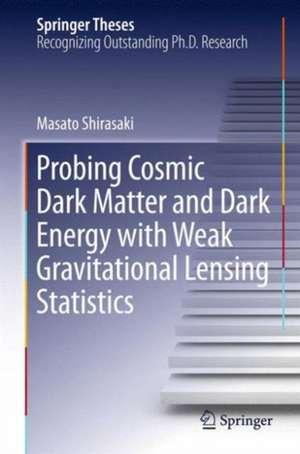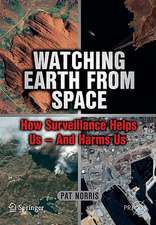Probing Cosmic Dark Matter and Dark Energy with Weak Gravitational Lensing Statistics: Springer Theses
Autor Masato Shirasakien Limba Engleză Hardback – 28 noi 2015
For cosmological constraints on the nature of dark energy, morphological statistics called Minkowski functionals (MFs) to extract the non-Gaussian information of gravitational lensing are studied. Measuring lensing MFs from the Canada–France–Hawaii Telescope Lensing survey (CFHTLenS), the author clearly shows that MFs can be powerful statistics beyond the conventional approach with the two-point correlation function. Combined with the two-point correlation function, MFs can constrain the equation of state of dark energy with a precision level of approximately 3–4 % in upcoming surveys with sky coverage of 20,000 square degrees.
On the topic of dark matter, the author studied the cross-correlation of gravitational lensing and the extragalactic gamma-ray background (EGB). Dark matter annihilation is among the potential contributors to the EGB. The cross-correlation is a powerful probe of signatures of dark matter annihilation, because both cosmic shear and gamma-ray emission originate directly from the same dark matter distribution in the universe. The first measurement of the cross-correlation using a real data set obtained from CFHTLenS and the Fermi Large Area Telescope was performed. Comparing the result with theoretical predictions, an independent constraint was placed on dark matter annihilation. Future lensing surveys will be useful to constrain on the canonical value of annihilation cross section for a wide range of mass of dark matter annihilation. Future lensing surveys will be useful to constrain on the canonical value of annihilation cross section for a wide range of mass of dark matter.
| Toate formatele și edițiile | Preț | Express |
|---|---|---|
| Paperback (1) | 633.19 lei 43-57 zile | |
| Springer Nature Singapore – 23 aug 2016 | 633.19 lei 43-57 zile | |
| Hardback (1) | 640.88 lei 22-36 zile | |
| Springer Nature Singapore – 28 noi 2015 | 640.88 lei 22-36 zile |
Din seria Springer Theses
- 18%
 Preț: 997.88 lei
Preț: 997.88 lei -
 Preț: 389.88 lei
Preț: 389.88 lei - 15%
 Preț: 646.94 lei
Preț: 646.94 lei - 18%
 Preț: 943.43 lei
Preț: 943.43 lei -
 Preț: 399.29 lei
Preț: 399.29 lei - 18%
 Preț: 944.99 lei
Preț: 944.99 lei - 15%
 Preț: 636.80 lei
Preț: 636.80 lei - 18%
 Preț: 941.05 lei
Preț: 941.05 lei - 15%
 Preț: 643.16 lei
Preț: 643.16 lei - 15%
 Preț: 642.68 lei
Preț: 642.68 lei - 18%
 Preț: 1103.62 lei
Preț: 1103.62 lei - 20%
 Preț: 558.82 lei
Preț: 558.82 lei - 18%
 Preț: 1112.30 lei
Preț: 1112.30 lei - 18%
 Preț: 944.19 lei
Preț: 944.19 lei - 18%
 Preț: 1109.92 lei
Preț: 1109.92 lei - 18%
 Preț: 1217.27 lei
Preț: 1217.27 lei - 15%
 Preț: 640.06 lei
Preț: 640.06 lei - 15%
 Preț: 636.45 lei
Preț: 636.45 lei - 15%
 Preț: 640.06 lei
Preț: 640.06 lei -
 Preț: 389.70 lei
Preț: 389.70 lei - 20%
 Preț: 563.89 lei
Preț: 563.89 lei -
 Preț: 393.35 lei
Preț: 393.35 lei - 15%
 Preț: 637.93 lei
Preț: 637.93 lei - 15%
 Preț: 641.85 lei
Preț: 641.85 lei - 18%
 Preț: 1225.94 lei
Preț: 1225.94 lei - 20%
 Preț: 551.36 lei
Preț: 551.36 lei - 18%
 Preț: 1229.10 lei
Preț: 1229.10 lei - 15%
 Preț: 639.25 lei
Preț: 639.25 lei - 18%
 Preț: 999.45 lei
Preț: 999.45 lei - 15%
 Preț: 640.06 lei
Preț: 640.06 lei - 18%
 Preț: 1220.45 lei
Preț: 1220.45 lei - 18%
 Preț: 1116.26 lei
Preț: 1116.26 lei - 18%
 Preț: 1110.72 lei
Preț: 1110.72 lei - 18%
 Preț: 1000.87 lei
Preț: 1000.87 lei - 18%
 Preț: 891.17 lei
Preț: 891.17 lei - 15%
 Preț: 640.06 lei
Preț: 640.06 lei - 5%
 Preț: 1154.07 lei
Preț: 1154.07 lei - 15%
 Preț: 635.96 lei
Preț: 635.96 lei - 15%
 Preț: 640.88 lei
Preț: 640.88 lei -
 Preț: 387.20 lei
Preț: 387.20 lei - 18%
 Preț: 1109.92 lei
Preț: 1109.92 lei -
 Preț: 385.25 lei
Preț: 385.25 lei -
 Preț: 385.25 lei
Preț: 385.25 lei - 18%
 Preț: 1112.30 lei
Preț: 1112.30 lei - 18%
 Preț: 999.45 lei
Preț: 999.45 lei -
 Preț: 386.99 lei
Preț: 386.99 lei - 15%
 Preț: 637.13 lei
Preț: 637.13 lei - 20%
 Preț: 554.20 lei
Preț: 554.20 lei - 20%
 Preț: 555.57 lei
Preț: 555.57 lei
Preț: 640.88 lei
Preț vechi: 753.97 lei
-15% Nou
Puncte Express: 961
Preț estimativ în valută:
122.63€ • 128.38$ • 101.47£
122.63€ • 128.38$ • 101.47£
Carte disponibilă
Livrare economică 17-31 martie
Preluare comenzi: 021 569.72.76
Specificații
ISBN-13: 9789812877956
ISBN-10: 9812877959
Pagini: 125
Ilustrații: XI, 136 p. 31 illus., 6 illus. in color.
Dimensiuni: 155 x 235 x 13 mm
Greutate: 0.43 kg
Ediția:1st ed. 2016
Editura: Springer Nature Singapore
Colecția Springer
Seria Springer Theses
Locul publicării:Singapore, Singapore
ISBN-10: 9812877959
Pagini: 125
Ilustrații: XI, 136 p. 31 illus., 6 illus. in color.
Dimensiuni: 155 x 235 x 13 mm
Greutate: 0.43 kg
Ediția:1st ed. 2016
Editura: Springer Nature Singapore
Colecția Springer
Seria Springer Theses
Locul publicării:Singapore, Singapore
Public țintă
ResearchCuprins
Introduction to observational cosmology.- Structure formation in the universe.- Weak gravitational lensing.- Weak lensing morphological analysis.- Cross correlation with dark matter annihilation sources.- Summary and conclusion.
Notă biografică
Dr. Masato Shirasaki
The University of Tokyo, Department of Physics
The University of Tokyo, Department of Physics
Textul de pe ultima copertă
In this book the applicability and the utility of two statistical approaches for understanding dark energy and dark matter with gravitational lensing measurement are introduced.For cosmological constraints on the nature of dark energy, morphological statistics called Minkowski functionals (MFs) to extract the non-Gaussian information of gravitational lensing are studied. Measuring lensing MFs from the Canada–France–Hawaii Telescope Lensing survey (CFHTLenS), the author clearly shows that MFs can be powerful statistics beyond the conventional approach with the two-point correlation function. Combined with the two-point correlation function, MFs can constrain the equation of state of dark energy with a precision level of approximately 3–4 % in upcoming surveys with sky coverage of 20,000 square degrees.
On the topic of dark matter, the author studied the cross-correlation of gravitational lensing and the extragalactic gamma-ray background (EGB). Dark matter annihilation is among the potential contributors to the EGB. The cross-correlation is a powerful probe of signatures of dark matter annihilation, because both cosmic shear and gamma-ray emission originate directly from the same dark matter distribution in the universe. The first measurement of the cross-correlation using a real data set obtained from CFHTLenS and the Fermi Large Area Telescope was performed. Comparing the result with theoretical predictions, an independent constraint was placed on dark matter annihilation. Future lensing surveys will be useful to constrain on the canonical value of annihilation cross section for a wide range of mass of dark matter.
Caracteristici
Nominated as an outstanding contribution by the University of Tokyo's Physics Department in 2015 Develops a statistical approach to reveal the nature of dark components in the universe Provides detailed comparisons with observations and high-end computing on matter distribution in the universe Makes an essential contribution to the statistical analysis in future galaxy imaging surveys by constructing mock observations Includes supplementary material: sn.pub/extras







